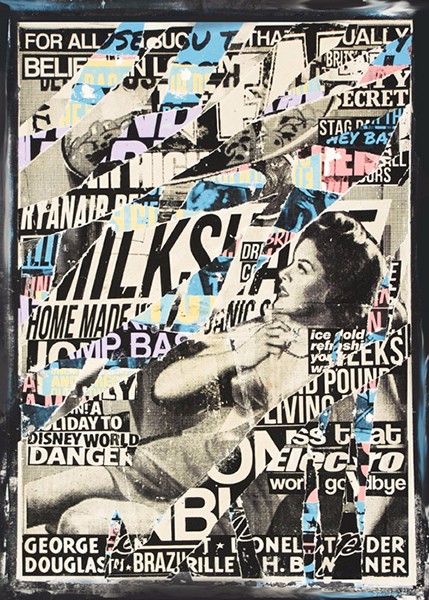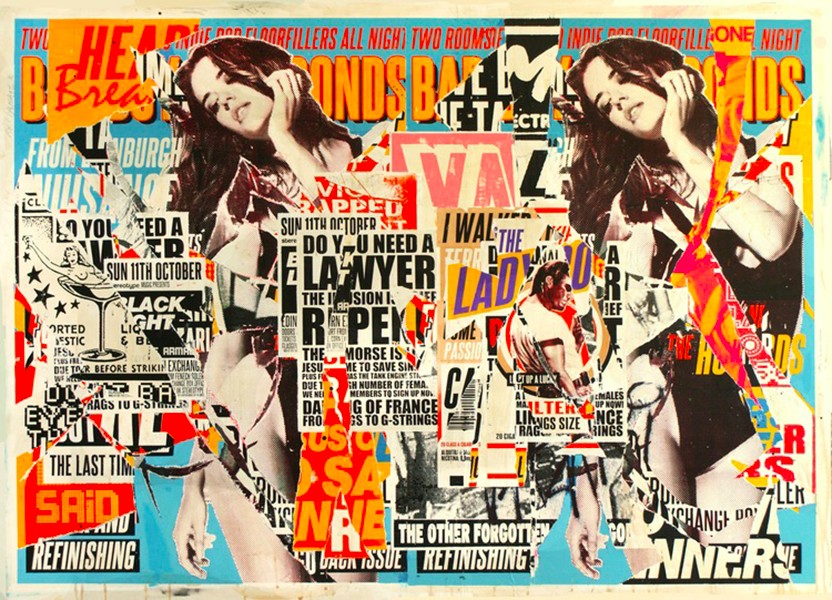Globe-trotter Charlie Anderson is one of the hardest artists to pin down, mainly because the Scottish painter is never in one place for too long. He has exhibited his work in Edinburgh, London, Berlin, Los Angeles and now Dubai. He was awarded the Meyer Oppenheim Prize by the Royal Scottish Academy in 2010, and some of his most notable collaborators include Ringo Starr, Ricky Hatton, and Amir Khano. Anderson’s effortless work uniform consists of paint-splattered jeans, trainer and a white T-shirt. It didn’t take long for fashion to take notice of Anderson’s devil-may-care attitude, and he can now list Mr. Porter and Coach as collaborators. For the image-maker, nothing is off limits when it comes to the ingredients that make up his larger-than-life pieces; from magazines to flyers to political campaigns. The actual process of manually reproducing images from mass media reflects the history of painting as documentation, and the contemporary way he uses the female form echoes the tradition of figurative painting in art. To celebrate the unveiling of his latest exhibition in Dubai, we caught up with the painter who highlights the throwaway nature of contemporary culture.
Mixing political messages, contemporary art and elements of the music industry and advertising – how does this mixture come to life?
It’s something that already exists visually all around us and therefore felt natural to include in my paintings.
What’s your proudest moment in your career to date?
Being threatened with a lawsuit.
What is your opinion on fashion? Where do you stand in today’s fashion-e-fied world? Please tell us about your Coach and Mr. Porter collaborations.
I find it very interesting. I like the idea that you can brand or characterise yourself in an individual way. I like the way trends have developed through history; it’s a lot like music or painting. The Mr. Porter collaboration was something I was invited to do for their first birthday celebration, using images of their idols that I turned into stencils and sprayed on canvas. The Coach collaboration was part of their ‘New York Stories’ series, where they invited people with some connection to New York City to film what they do and tell their story.
Where / how do you sell your art and how do you go about pricing it?
I sell through galleries and dealers. The price is something that developed itself over the years, based on demand for the work and the costs involved in producing and selling it. It stays consistent across the galleries with the aim of increasing it by a slight percentage each year.
Do all your pieces have an underlying message, or is it about the multitude of messages in a piece?
Usually it’s a series of paintings that explores one idea as opposed to exploring different ideas with each individual painting. Often though, it is as much about the artisan craft of making the paintings as it is about the idea I’m exploring.
What do you hope to achieve with your art?
In a way that’s something I’m trying to figure out. My techniques and ideas develop, and my goals shift, but that keeps the whole process exciting for me I don’t tend to think too far ahead.
Do you feel attached to the work you created or is it easy for you to say goodbye to it?
I don’t mind seeing them go – it helps me develop and make better paintings if I’m not holding on to the old ones. I’m happy that they exist somewhere out in the world.
This might be a little cliché, but we have to know, what inspires you the most?
Things that people do exceptionally well, whether they are artists, musicians, authors, athletes etc. The drive for me is more about the will to succeed at what I do as opposed to the need to pick up a brush and paint something.
Can you talk to us about your most recent exhibition that took place in the Lulu Laboratorium during Miami Art Week?
The exhibition took place in a very big space, which gave me the chance to make a lot of big paintings. That was my initial preoccupation, to make a series of big paintings. Subject-wise I was designing big posters based on my daily life experiences, using images I found and then manipulating them into something new, mixing them with bits of text I came across to change their context. It was a way of exploring the changing significance of things based on how you perceive them. I was going for a melodramatic low-brow feel, but spending a lot of time composing and painting each work. It was a kind of oxymoron; the sort of frantic, kitchsy visual effect against the very slow and deliberate process of painting.
Interview: Nada Abdul Ghaffar











